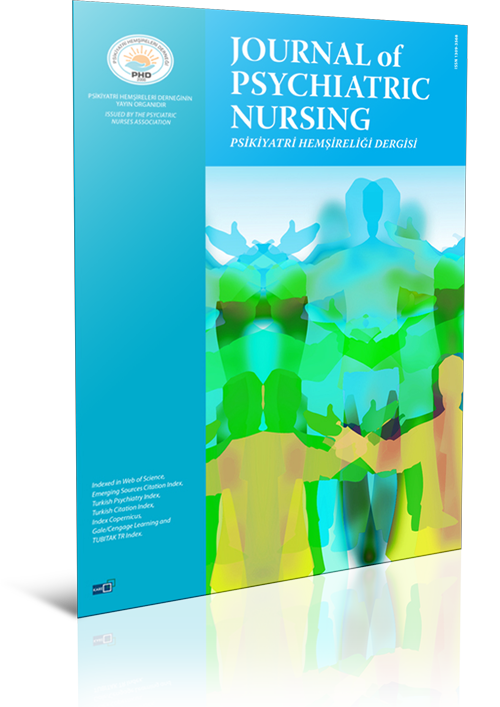
Volume: 2 Issue: 1 - 2011
| 1. | Frontmatter Pages I - III |
| RESEARCH ARTICLE | |
| 2. | An Analysis of the Nurse Academicians Attitude Towards Work Life Serap Yıldırım, Olcay Çam Pages 1 - 8 OBJECTIVE: This study was planned in order to determine nurse academicians attitude towards their work life. METHODS: A descriptive research was carried out during the 2007-2009 academic years in the Department of Nursing of the Faculty of Health Sciences and Nursing High Schools in the public and private Universities of Turkey. Two hundred and eighty-seven nurse academicians accepted to join the research. Data were collected with an Introductory Information Form and the Job and Organization-Related Attitude Scale. RESULTS: The mean score of job satisfaction among nurse academicians was 3.30±0.70, of organizational commitment 3.44±0.85, of job involvement 3.49±0.80, of job motivation 4.37±0.66, and of intent to stay 3.94±1.09. It was determined that there was a statistically significant relationship between the nurse academicians age, perceived economic situation, academic degree, their position as a researcher, total working years, and their working years as a nurse academician and the Job and Organization-Related Attitude Scale and subscale mean scores (p<0.05). CONCLUSION: According to our results, job motivation among nurse academicians was high, while their job satisfaction was low. It is suggested to take precautions to ameliorate unsatisfactory attitudes by taking into consideration all individual and institutional factors that affect nurse academicians attitudes towards their work life and new arrangements should be made if determined necessary. |
| 3. | Determination of Workplace Violence Toward Health Workers in Kocaeli* Oya Çamcı, Yasemin Kutlu Pages 9 - 16 OBJECTIVE: The aims of this study were to determine the prevalence of workplace violence, types of workplace violence and the individual and job characteristics that affect workplace violence among health workers. METHODS: This study was planned as a descriptive and cross-sectional research. The study sample was comprised of 270 health workers in 12 different hospitals, which provide secondary and tertiary health services in Kocaeli. A questionnaire form was prepared by the researcher and was designed to determine the individual and job characteristics and the prevalence of workplace violence. RESULTS: The mean age of the participants was 29.51±5.86 years. The rate of their exposure to violence in their lifetime was 72.6%, and the rate of violence in the last 12 months was 72.4%. The most frequently seen violence form was verbal abuse (98.5%), and it was determined that the violence was applied primarily by the patients relatives and by males. CONCLUSION: Today, violence, which is disseminative, affects the health sector forcibly. It has been determined that the majority of the health workers are exposed to some type of violence. Thus, it is important to take necessary measures to prevent workplace violence. |
| 4. | Determination of the Relationship Between Family Functionality and Locus of Control and Levels of Academic Success Among Nursing Students Satı Dil, Özlem Bulantekin Pages 17 - 24 OBJECTIVE: This research was conducted to determine the relationship between family functionality, locus of control, levels of academic success, and sociodemographic characteristics among nursing students. METHODS: This research was conducted in April-May 2010 as a descriptive and cross-sectional research with 126 students in a nursing department. A 15-item questionnaire including sociodemographic characteristics of students, Rotters Internal-External Locus of Control Scale (RIELCS) and the Family Assessment Device (FAD) were used as data collection tools. The data were evaluated using percentages, t-test, one-way ANOVA, and Pearsons correlation analysis. RESULTS: It was determined that the mean General Academic Success (TGAS) score was 2.55 ± 0.52. The mean score of the Affective Involvement subscale of FAD (2.15 ± 0.38) was the highest, while the mean score of the General Functioning subscale of FAD (1.55 ± 0.42) was the lowest. A positive correlation was found between the total scores of RIELCS and the Communication subscale of FAD in the correlation analysis (r=0.197, p<0.05). It was found that there were statistically significant differences between the type of family and the Affective Responsiveness subscale of FAD, between education levels of the students mothers and the Affective Involvement subscale of FAD, between students with mental illness and the Affective Involvement subscale of FAD, between the Accommodation of Students and the Roles subscale of FAD, between the socioeconomic status of students and the total score of RIELCS, and between students having social security and the total score of RIELCS (p<0.05). CONCLUSION: Our results indicated that there is no statistically significant relation between the total scores of FAD and RIELCS and TGAS levels of students. |
| 5. | Loneliness and Effective Factors in Alcohol and Drug Dependence Bilge Yıldırım, Esra Engin, Serap Yıldırım Pages 25 - 30 OBJECTIVE: This study was conducted to determine the extent of loneliness and effective factors in alcohol and drug dependence. METHODS: A descriptive study was carried out between April - September 2008 in Ege University Medical Faculty Hospital, Department of Psychiatry Clinic, Alcohol and Drug Dependency Unit with 200 patients who accepted to join the research. The research data were collected with a descriptive information form and the UCLA Loneliness Scale. The data were analyzed by ANOVA and t-test. RESULTS: The mean age of the alcohol- and drug-dependent patients was 39.55±12.86 years. It was determined that 79% of the patients were male, 58% were married, 49% had graduated from high school, 58% were employed, 66% perceived their income as moderate level, 89.5% had social security, and 84.5% of the dependent patients lived in a nuclear family. When we investigated the loneliness characteristics in this patient group, it was found that 71% of them had experienced loneliness, 35.9% experienced loneliness often, and 27.5% spent their leisure time involved with cultural/arts and intellectual activities. The mean loneliness scale score was 38.51±14.39, and marriage status, education level, perceived income level, and family type affected the loneliness scale mean score (p<0.05). CONCLUSION: It has been suggested that because of the Turkish family type and social support available to alcohol- or drug-dependent individuals, the loneliness score was determined to be low. |
| 6. | Factors Affecting Stigmatization About Mental Disorders Among Adolescents Gül Oban, Leyla Küçük Pages 31 - 39 OBJECTIVE: The purpose of this study was to investigate factors that affect stigmatization about mental disorders among adolescents. METHODS: The study was carried out in April-May 2010 with 60 randomly selected high school students (age range: 14-19 years) from Nişantası Nuri Akın Anatolian High School in İstanbul who accepted to participate in the study. Data were collected with a questionnaire form, Social Distance Scale, and the Attitude and Belief Scale Toward Mental Illness prepared by the researcher using the literature. For the data analysis, statistical descriptive (percentage, arithmetic mean, standard deviation) and comparative (Kruskal-Wallis, Mann-Whitney U) methods were used. RESULTS: Our results showed that there was no significant correlation between the students social distance and attitude toward mental disorders and their gender, economic status, presence of psychiatric family history, or the presence of a mental disorder that they frequently hear of and know about. However, a statistically significant correlation was determined between the students social distance and attitude toward mental disorders and a personal psychiatric history, previously acquired knowledge about mental disorders, their thoughts about the patients legal rights, the presence of a mental disorder that they consider to be dangerous, their belief that a mental disorder can develop as a result of living with someone with a mental disorder, and their feeling of uncomfortableness about living in a city or town in which a mental hospital is located. CONCLUSION: It was seen that adolescents have a negative attitude toward and a desire to maintain a social distance from individuals with mental disorders. We recommend that mental health nurses utilize school programs in order to increase the awareness of adolescents toward mental disorders and to reduce the associated stigmatization. |
| REVIEW | |
| 7. | How Do Irrational Beliefs Affect Test Anxiety During Adolescence? Nur Elçin Boyacıoğlu, Leyla Küçük Pages 40 - 45 The early adolescence period includes the first years of the transition to adolescence, which is experienced after childhood. During this period, new situations causing anxiety emerge, specific to this growth. In the early adolescence period, which covers approximately the ages of 11-14 years, in parallel with the physical and hormonal changes observed in puberty, anxiety together with shyness, guilt, depression, and negative emotions such as anger are experienced intensively. We aimed in this study to discuss the irrational beliefs that the students have about themselves, about others and about the world they live in, and the effect of these beliefs on their anxiety level. We hope to contribute to the literature by stressing the importance of taking anxiety into consideration in the educational and interventional programs developed for adolescents. |


















